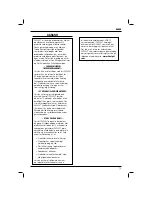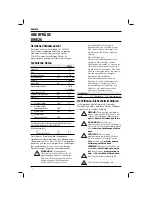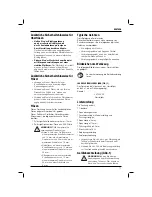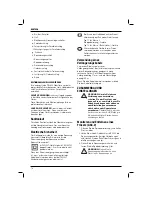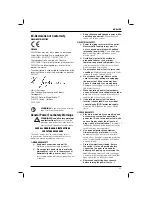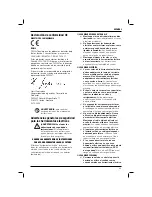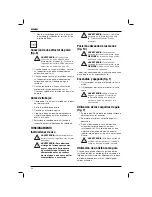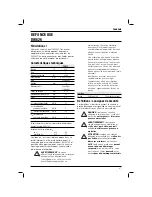
ENGLISH
26
wrench or a key left attached to a rotating
part of the power tool may result in personal
injury.
e)
Do not overreach. Keep proper
footing and balance at all times.
This
enables better control of the power tool in
unexpected situations.
f)
Dress properly. Do not wear loose
clothing or jewellery. Keep your hair,
clothing and gloves away from moving
parts.
Loose clothes, jewellery or long hair
can be caught in moving parts.
g)
If devices are provided for the connection
of dust extraction and collection facilities,
ensure these are connected and properly
used.
Use of dust collection can reduce
dust-related hazards.
4) POWER TOOL USE AND CARE
a)
Do not force the power tool. Use the
correct power tool for your application.
The correct power tool will do the job
better and safer at the rate for which it
was designed.
b)
Do not use the power tool if the switch
does not turn it on and off.
Any power
tool that cannot be controlled with the switch
is dangerous and must be repaired.
c)
Disconnect the plug from the power
source and/or the battery pack from
the power tool before making any
adjustments, changing accessories, or
storing power tools.
Such preventive safety
measures reduce the risk of starting the
power tool accidentally.
d)
Store idle power tools out of the reach
of children and do not allow persons
unfamiliar with the power tool or these
instructions to operate the power tool.
Power tools are dangerous in the hands of
untrained users.
e)
Maintain power tools. Check for
misalignment or binding of moving parts,
breakage of parts and any other condition
that may affect the power tool’s operation.
If damaged, have the power tool repaired
before use.
Many accidents are caused by
poorly maintained power tools.
f)
Keep cutting tools sharp and clean.
Properly maintained cutting tools with sharp
cutting edges are less likely to bind and are
easier to control.
g)
Use the power tool, accessories and
tool bits etc., in accordance with these
instructions taking into account the
working conditions and the work to
be performed.
Use of the power tool for
operations different from those intended
could result in a hazardous situation.
5) SERVICE
a)
Have your power tool serviced by a
qualified repair person using only identical
replacement parts.
This will ensure that the
safety of the power tool is maintained.
Additional Specifi c Safety Rules for
Routers
•
Hold power tool by insulated gripping
surfaces, because the cutter may contact
its own cord.
Cutting a “live” wire may make
exposed metal parts of the power tool “live” and
shock the operator.
•
Use clamps or another practical way to
secure and support the workpiece to a
stable platform.
Holding the work by your
hand or agains the body leaves is unstable and
may lead to loss of control.
Additional Specifi c Safety Rules for
Cutters
• Always use cutters with a shank diameter
corresponding to the size of the collet installed
in your tool.
• Always use cutters suitable for a speed of
30,000 min
-1
and marked accordingly.
• Never use cutters with a diameter exceeding the
maximum diameter indicated in the technical
data.
Cutters
The tooling can be used with the complete range
of commercial cutters (e.g: straight, rebate, profile
cutter, slotter cutter or grooved knife) with the
following technical data:
1. Allowed shank diameter 1/4"– 1/2".
2. Approved speed of cutter min. 30,000/min.
WARNING:
DW626 max diameter to
use:
• Straight, rabbet or profile cutter with
max shank diameter (1/2"), Max
diameter 50 mm, Max cutting depth
10 mm.
•
Slotter cutter with max shank diameter
(1/2"), Max diameter 25 mm
•
Grooved knife with max shank
diameter (1/2"), Max diameter
40 mm and 4 mm cutting width.


